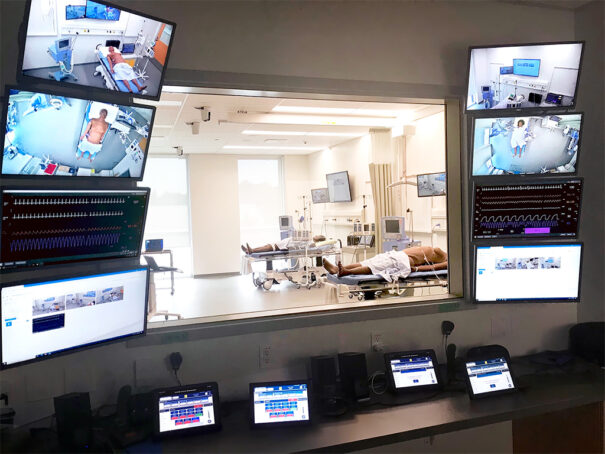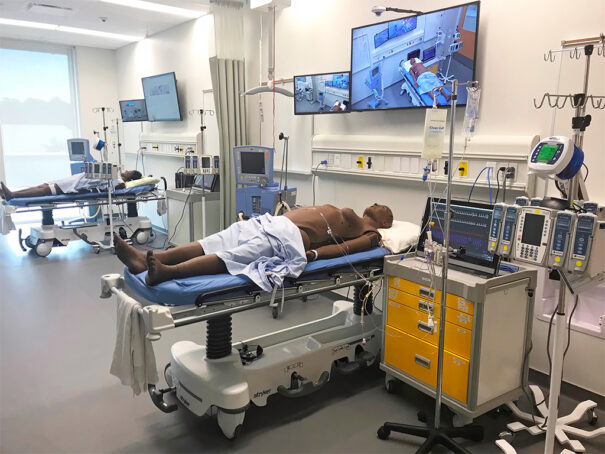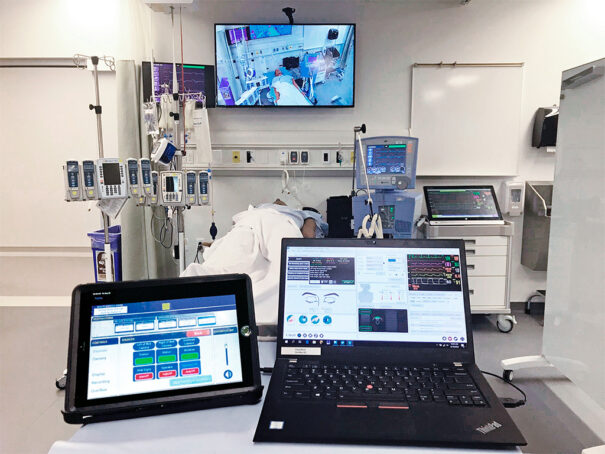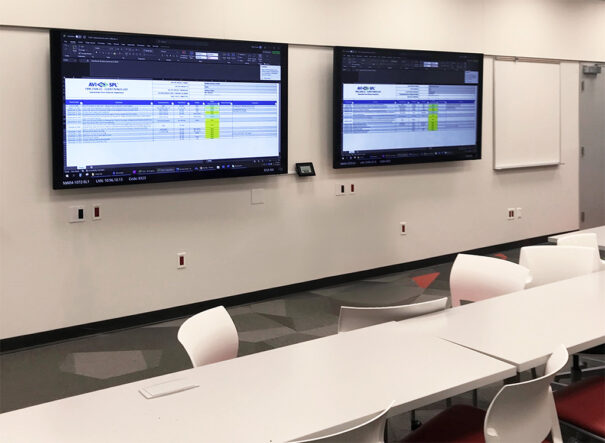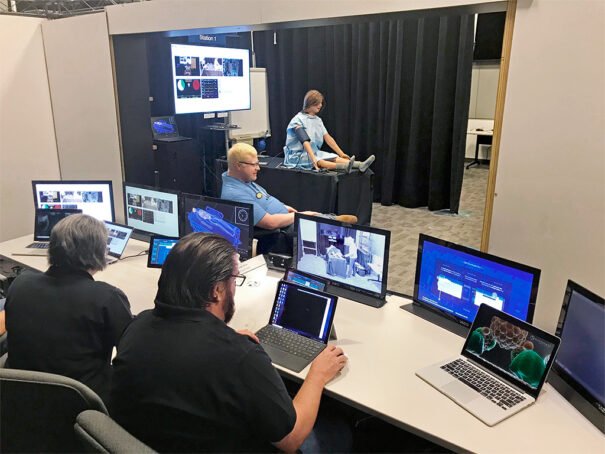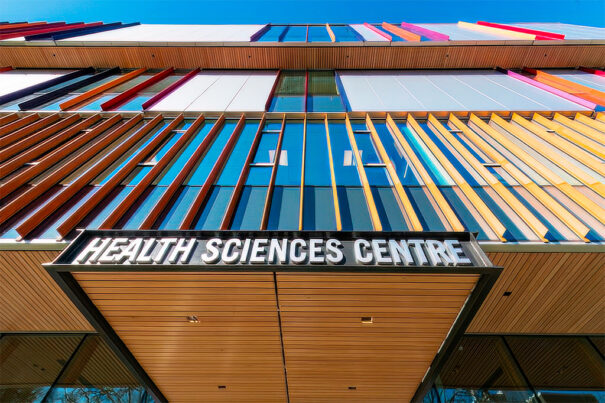Extron AV Technology Powers Healthcare Training at BCIT
Aunque los productos de Extron se utilizan en toda la instalación, son de destacar los sistemas audiovisuales que dan soporte a los laboratorios de simulación del HSC del British Columbia Institute of Technology (BCIT), que permiten a los estudiantes aprender a practicar la medicina de forma segura en entornos controlados.
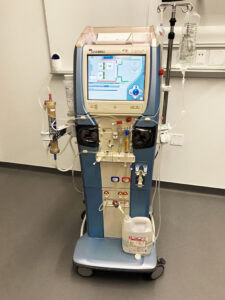 He sistema integrado NAV de Extron y otros productos y tecnologías están ayudando a garantizar en el nuevo HSC del British Columbia Institute of Technology (BCIT) que los estudiantes reciban la instrucción y la experiencia que necesitan para atender mejor las necesidades médicas de los ciudadanos de Columbia Británica.
He sistema integrado NAV de Extron y otros productos y tecnologías están ayudando a garantizar en el nuevo HSC del British Columbia Institute of Technology (BCIT) que los estudiantes reciban la instrucción y la experiencia que necesitan para atender mejor las necesidades médicas de los ciudadanos de Columbia Británica.
El BCIT de Vancouver (Columbia Británica – Canada) necesitaba más espacio para dar respuesta a la creciente necesidad de profesionales sanitarios bien formados en toda la provincia. Su Facultad de Ciencias de la Salud construyó el nuevo Centro de Ciencias de la Salud (HSC) en el campus de Burnaby para satisfacer esta demanda.
Para reforzar los estudios teóricos con experiencias basadas en escenarios, el nuevo HSC se diseñó para ofrecer espacios de aprendizaje colaborativo y equipos médicos de vanguardia unidos a tecnologías audiovisuales de apoyo.
Las nuevas instalaciones tenían que mejorar las capacidades tecnológicas del centro anterior en cuanto a funcionalidad, capacidad de respuesta y opciones y oportunidades de tratamiento. Besides, debía cumplir los requisitos específicos de cada uno de los 32 programas sanitarios de la escuela, included 17 programas tradicionales y especializados de enfermería y 15 de diagnóstico por resonancia magnética, radioterapia, salud y seguridad en el trabajo y salud medioambiental. Los objetivos estructurales eran mejorar las líneas de visión, amortiguar el ruido y mejorar la acústica de cada espacio.
Entre los requisitos del sistema audiovisual se incluyen una calidad de vídeo óptima, conmutación instantánea de señales AV, conversión de vídeo entre formatos de señal, sonido impecable y capacidad de captura y transmisión de conferencias.
El control intuitivo del sistema debía estar disponible desde múltiples ubicaciones, incluidos los paneles táctiles instalados y los dispositivos portátiles inalámbricos. El contenido va dirigido a la presentación local y la visualización remota para enviarlo a través del campus y más allá.
Los sistemas de laboratorio asimilan las señales generadas por una amplia variedad de fuentes, como ordenadores, PTZ cameras, equipos médicos y maniquíes de simulación de pacientes humanos dotados de tecnología. Besides, cada sistema audiovisual debía facilitar la observación remota en tiempo real y la comunicación privada y pública entre el laboratorio y la sala de control.
Para cumplir estos requisitos, la empresa consultora McSquared Design Group seleccionó productos y software audiovisuales de Extron.
“La realización de pruebas de concepto de aplicaciones nunca ha sido tan importante como ahora, dada la complejidad de los sistemas audiovisuales y los retos que conlleva. El equipo de Extron ha desempeñado un papel vital en la realización de las pruebas POC y en la validación del diseño”, explains Marcel Schoenenberger, consultor principal McSquared System Design Group Inc.
Solución de diseño
La planificación, construcción y rigurosas pruebas de concepto de los sistemas audiovisuales, combinado con el despliegue de equipos realizado por AVI-SPL Canada, dieron como resultado una gran instalación de aprendizaje.
Con sus cuatro plantas y un total de 9.909 square meters, el HSC es la instalación de formación sanitaria, basada en situaciones, más importante de Canadá. Abarca aulas de aprendizaje activo, salas de conferencias y reuniones, laboratorios informáticos, un auditorio divisible y muchos de enseñanza de programas específicos.
Although Extron products are used throughout the facility, son de destacar los sistemas audiovisuales que dan soporte a los laboratorios de simulación que permiten a los estudiantes aprender a practicar la medicina de forma segura en entornos controlados.
Los laboratorios de simulación abarcan desde entornos hospitalarios y de laboratorio médico hasta entornos de respuesta a emergencias y triaje. Disponen de salas de tratamiento, camas de pacientes con tecnología mejorada, carros de paradas con conectividad audiovisual, sistemas de llamada de enfermería, un sistema de dispensación de medicación y kits de mimetización para la formación en respuesta a crisis.
Cada laboratorio está asociado a una de las control rooms e incluye ocho puestos de camas. Desde cada puesto de la sala de control se gestionan dos camas, lo que permite ejecutar varios escenarios simultáneamente. Alrededor de cada cama hay de una a cuatro cámaras PTZ, un sistema de micrófonos inalámbricos Shure, un altavoz montado en el techo y una pantalla Sharp NEC of 50 pulgadas que se encuentra instalada en la pared.
Las cámaras PTZ montadas sobre cada cama capturan las actividades del escenario para su transmisión/archivo y facilitan la observación y la interactividad con el operador de la sala de control.
Las estaciones de camas añaden un monitor de 24 pulgadas en un brazo articulado, dos entradas HDMI bajadas del techo, una placa de pared con al menos una entrada HDMI y una cámara de lente fija integrada en la lámpara quirúrgica.
Algunas salas de demostración también cuentan con dispositivos médicos especializados, como una ecografía doppler o una máquina de diálisis renal.
El contenido mostrado puede incluir cualquier combinación de constantes vitales procedentes del simulador de paciente o de un ordenador, otros datos sanitarios generados por ordenador o por el equipo, y la alimentación de la cámara PTZ.
Vinculados a los sistemas audiovisuales están el LMS, el Health Capture & Debriefing System – HCDS, y/o el servicio de gestión y alojamiento de contenidos de captura de conferencias Kaltura.
La instalación puede capturar hasta cuatro secuencias de vídeo para su visualización simultánea en un diseño de ventana cuádruple a 1080p o un canal de vídeo a pantalla completa en 4K. Cada flujo también se archiva para su posterior reproducción.
La instalación cuenta con más de 50 maniquíes portátiles, simuladores de pacientes humanos. Cada cama dispone de uno de estos maniquíes conectado al sistema AV junto con equipos médicos especializados.
Un panel táctil TouchLink Pro 10″ de Extron está montado en el cabecero para controlar las operaciones del sistema. Los maniquíes pueden presentar una amplia gama de dolencias, y muchos pueden imitar una o más reacciones humanas, como hemorragias, gemidos y llantos.
Cada simulador de paciente tiene un altavoz integrado y la mayoría incorpora un micrófono para las sesiones de diagnóstico entre los estudiantes en el laboratorio y un confederado en la sala de control. Un router de red integrado permite que cada unidad esté en su propia red WiFi.
Conexión total con NAV Pro AVoIP
El sistema NAV conecta los espacios activos de aprendizaje/enseñanza, los laboratorios y las instalaciones de simuladores, con la flexibilidad de dirigir cualquier fuente a cualquier pantalla.
Los codificadores NAV se conectan a cámaras PTZ y domo en los puestos de pacientes y a conexiones HDMI de ordenador y placa de pared, tanto en los puestos de pacientes como en los de enseñanza.
More than 230 codificadores NAV transmiten vídeo de alta calidad y latencia ultra baja y audio AES67 a través de la red IP. More than 170 decodificadores NAV reciben las señales de los codificadores y proporcionan una calidad de imagen perfecta en grandes pantallas y monitores de sobremesa en las distintas estaciones del centro.
“El centro de Ciencias de la Salud del BCIT viene con una ampliación de recursos que son fundamentales para garantizar que la generación actual y futura de profesionales sanitarios esté bien respaldada para atender a la gente de la provincia. Estoy perfeccionando mis habilidades utilizando tecnología punta para formar parte de un sector que marca la diferencia a largo plazo”, comenta Carla Lucero, licenciada en Enfermería en BCIT.
ShareLink Pro y LinkLicense para el aprendizaje activo
Las estaciones están equipadas con pasarelas de presentación inalámbricas ShareLink Pro by Extron. Proporcionan una conectividad segura, introduciendo contenido procedente de tabletas escolares y otros dispositivos portátiles autorizados en el sistema AV de cada laboratorio. Esto también permite el acceso de la placa de pared HDMI a los codificadores NAV. La pasarela de colaboración incluye una actualización de LinkLicense para Active Learning.
Esta tecnología de Extron facilita el uso de varias pantallas, lo que permite comparar y debatir entre grupos de estudiantes o entre el profesor y los estudiantes. También permite manejar cada estación de cama desde su tableta asociada, que ejecuta la aplicación Extron Control. Los sistemas AVoIP y de control residen y funcionan en la red empresarial convergente con multidifusión.
Algunas salas admiten aprendizaje a distancia y colaboración a través de Zoom. El software de videoconferencia se instala en un ordenador host dedicado conectado al sistema AV a través de un puente USB MediaPort 200 by Extron.
Para garantizar la calidad del sonido y la claridad de las grabaciones, cada laboratorio cuenta con un procesador de matriz de expansión de audio de la serie XMP by Extron.
Their 24 canales de AEC facilitan una comunicación clara entre las estaciones de la cama y las ubicaciones remotas. El procesador proporciona conectividad Dante para 48 fuentes y 48 destinos. El personal de asistencia utiliza Dante Domain Manager para gestionar la autenticación de usuarios y la seguridad basada en funciones, con interfaces de audio Dante de la serie AXI de Extron que proporcionan las entradas y salidas de audio cuando es necesario. Esta solución permite la expansión sin problemas de los sistemas Dante a través de la red BCIT.
Extron Control
En la mayoría de los casos, un operador de la sala de control gestiona los sistemas conectados y proporciona respuestas verbales remotas a los participantes en el escenario.
El instructor puede controlar el simulador de paciente, el equipo médico asociado a la cama, los ordenadores y otras fuentes, y el sistema AV desde la cabecera de la cama utilizando el panel táctil montado en el cabecero o una tableta con la aplicación Extron Control.
Cuando el instructor elige ejecutar el escenario desde la sala de control, un operador en la estación de trabajo gestiona el equipo. El instructor utiliza un micrófono de sobremesa o un micrófono de solapa o auriculares inalámbricos para comunicarse con el confederado en el laboratorio, que lleva un auricular.
La comunicación bidireccional general entre la sala de control y el laboratorio es posible utilizando un micrófono de pulsar para hablar en cada estación de trabajo del operador y el micrófono y altavoz de techo asociados a cada estación de cama. Sea cual sea el método, todos los intercambios se capturan y se ponen a disposición para su transmisión y archivo.
El sistema de control de cada laboratorio se basa en un procesador de control IP Link Pro de Extron con LinkLicense, y los laboratorios más grandes tienen más de uno. Los procesadores de control se han programado con Global Scripter, el entorno de desarrollo basado en Python de Extron. La interfaz de usuario se ha creado con GUI Designer para garantizar que el diseño sea intuitivo y fácilmente reproducible en los numerosos dispositivos táctiles.
El nuevo HSC del BCIT es el mayor centro de formación sanitaria basada en simulación de Canadá y está reconocido como uno de los más avanzados del mundo. Desde el primer día de clase, ha estado apoyando una educación clínica innovadora y progresiva mediante el aprendizaje activo y sofisticadas simulaciones.
Did you like this article?
Subscribe to our NEWSLETTER and you won't miss anything.



